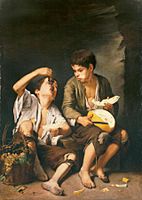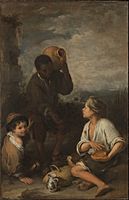The Young Beggar facts for kids
Quick facts for kids The Young Beggar |
|
|---|---|
 |
|
| Artist | Bartolomé Esteban Murillo |
| Year | c. 1645–50 |
| Medium | oil on canvas |
| Dimensions | 134 cm × 300 cm (53 in × 120 in) |
| Location | Louvre, Paris |
The Young Beggar is a famous painting by the Spanish artist Bartolomé Esteban Murillo. He painted it around 1645–1650. This artwork shows a scene from everyday life, which is called a genre painting.
The painting is also known as The Lice-Ridden Boy. This is because it shows a young boy picking lice from his hair. It was the first time Murillo painted a street urchin, which means a homeless child.
Murillo was inspired by the many poor children in Spain during the 1600s. His painting focuses on a child who might be an orphan. He used a special way of painting with light and shadow, similar to the artist Caravaggio.
The Young Beggar is one of Murillo's most popular works from the Spanish Baroque painting period. It was once part of the royal art collection of King Louis XVI of France. Today, you can see it at the Louvre Museum in Paris, France.
Contents
The Story Behind the Painting
Paintings showing children in poverty were very popular in a region called Flanders (modern-day Belgium and Netherlands). People there liked art that showed everyday life, including scenes from taverns.
Murillo was one of the last great painters of Spain's Golden Age. He was mostly known for his religious paintings. He often painted saints and scenes about Christ.
His interest in poor people might have come from the Franciscans. These are a group of religious people who focus on helping others. Murillo often worked for them. He even painted a series of pictures for the Franciscans in Seville, Spain. One of these paintings is called The Angels' Kitchen.
How the Painting Became Famous
Murillo's paintings of street children and beggars became very popular later in the Baroque art period. People bought them for their own private art collections. These paintings were sold in cities like Antwerp, Rotterdam, and London.
Most buyers were merchants and collectors. They wanted these artworks to display in their homes. The Young Beggar was one of Murillo's most sought-after pieces.
An art dealer named Lebrun bought it. He then gave it to King Louis XVI for his royal collection. This was a big deal! Murillo was one of only three Spanish painters whose work was in the king's collection. The other two were Diego Velázquez and Francisco Collantes.
Other Paintings by Murillo
See also
 In Spanish: Joven mendigo para niños
In Spanish: Joven mendigo para niños



